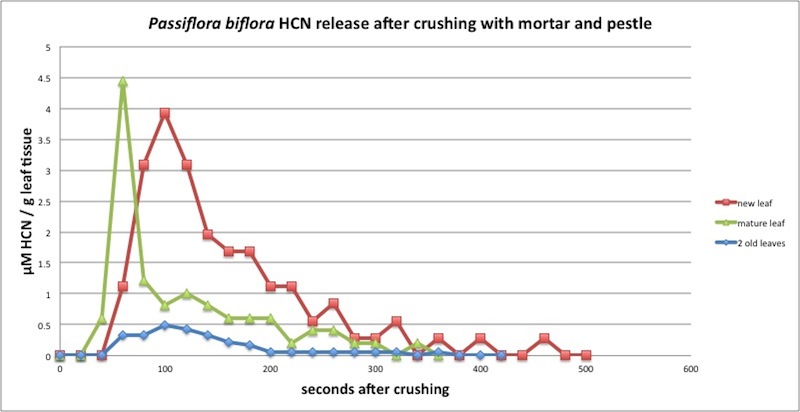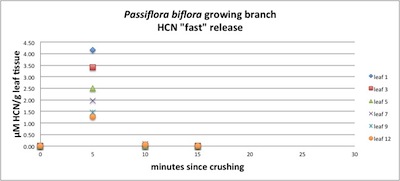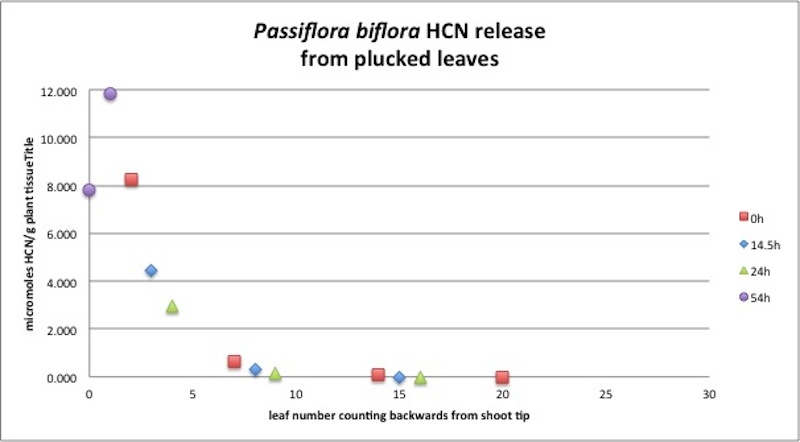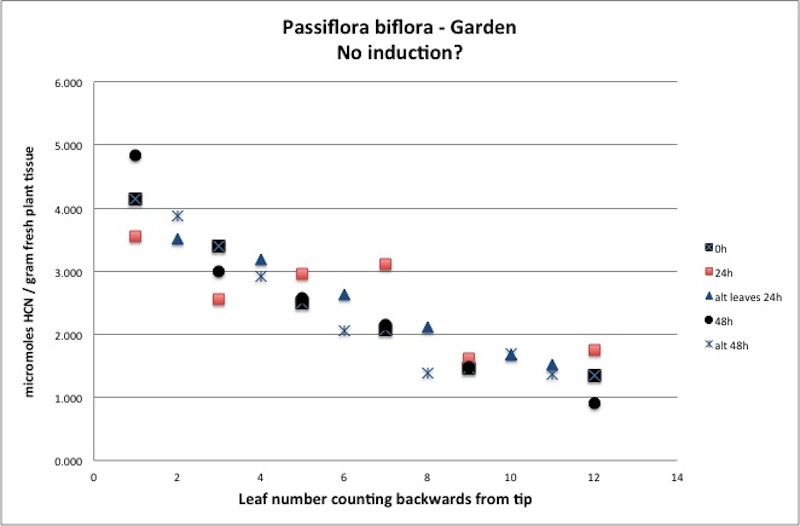Passiflora biflora
P. biflora is one of the most common species of Passiflora in second growth and edge habitats at La Selva. The two-lobed leaf shape and the nectaries on the leaf blades are distinctive. The nectaries are attractive to egg parasitoids and ants. The stems are slender, flexible and strong, and have 6-8 longitudinal ridges. Range: Mexico to Ecuador and Venezuela. P. biflora is widespread in Costa Rica. P. biflora is one of 120 species belonging to section Decaloba, subgenus Decaloba. The only other local member of this section is rare at La Selva and is found in the higher elevations, P. lancearia.
P. biflora foliage is slightly to strongly cyanogenic when crushed (0.2 to 10 μM/g HCN per gram tissue). According to Spencer (1988) P. biflora contains the cyclopentenoid cyanogens Passibiflorin and Epipassibiflorin. It is interesting to note that larval growth rate measurements at controlled temperatures showed Decaloba-specialist H. erato growing about 10% faster than the Passiflora generalist H. cydno when feeding on P. biflora (Smiley 1985a). Perhaps erato is able to use the cyanogenic glycosides as nutrients, as proposed for H. sara feeding on P. auriculata. HCN measurements on P. biflora rootlets from three different plants indicated substantially lower values than in the foliage (.032-.112 μM/g), a 90% reduction not seen in other Passiflora species at La Selva (with the possible exception of P. pittieri).
H. cydno, H. hecale and especially H. erato lay their eggs on P. biflora at La Selva, the former species on the tendril tips and the latter laying single eggs on the shoot tips among the incipient leaves. The rare species H. hecalesia has also been seen laying eggs on this plant altough it is known to prefer P. lancearea as host. The heliconiid Dryas iulia also lays eggs on the new leaves.
This species is also eaten by several species of flea beetle, including the generalist Blue Flea Beetle (Monomacra violacea), the Yellow-legged Flea Beetle (Parchicola DF2), the Red-black Flea Beetle (Monomacra chontalensis), and the Red-brown-white Flea Beetle (Ptocadica bifasciata). The Yellow-tibia Flea Beetle (Parchicola "Yellow-tibia") has been observed on P. biflora, along with the rare (at La Selva) Striped Flea Beetle (Disonycha quinquelineata). I have also found leaf-feeding larvae of D. quinquelineata on P. biflora at La Selva.
I confined Parchicola DF2 and Monomacra chontalensis in experimental cages with potted P. biflora for 2-3 months, on three separate occasions, but no reproduction occurred. I may have had too few individuals (3 of unknown gender) of M. chontalensis for a fair test.
Measurements of HCN production in P. biflora foliage show many patterns of variation among leaves. One branch that was growing in shade appeared to be actively withdrawing HCN capacity toward the roots from the newer leaves. Another, vigorously growing plant showed a variable response to leaf damage which disappeared after 48h. As compared with P. auriculata, P. biflora is 5-10 times more cyanogenic, and shows more within-plant variation in cyanogenesis. (See Figure 5).






